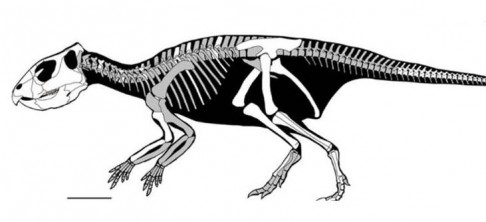

The remains of a dinosaur believed to date back to the Upper Cretaceous period were recovered from a formation in Neixiang, a county in central China’s Henan province. Photo: SCMP Pictures
Dinosaurs may have regressed biologically at some point in history and re-adopted characteristics of their ancestors, according to a new study by Chinese scientists.
Palaeontologists discovered what could be the first evidence of reverse evolution among them on the skeleton of a horned dinosaur.
The specimen was recovered from a rock formation in Neixiang, a county in central China’s Henan province, dating back to the Upper Cretaceous period.
This was the final period when dinosaurs stood as the dominant land animals. It ran from about 100 million to 66 million years ago.
Horned dinosaurs like the triceratops, also known as ceratopsians, were beaked herbivores that grazed over much of the planet from North America to Asia for over 100 million years. Their ancestors date back to the earlier Jurassic period.
The earliest fossil found in China of this group is believed to be about 160 million years old.

A drawing of what the unearthed specimen may have looked like in greater depth. Photo: SCMP Pictures
The species dug up in Henan, called Mosaiceratops azumai, contained important features suggesting that the upper teeth of horned dinosaurs may have evolved into a beak and then "devolved" back to the more primitive form with teeth.
Devolution has long been ruled out as a widespread phenomenon but occasionally throwbacks to earlier ancestral characteristics are found on humans and animals.
One example would be a baby born with a developed tail instead of the normal coccyx, which is effectively a truncated tailbone.
But in recent years, some biologists have observed how such dramatic biological changes can affect an entire species, such as a lizard or frog re-growing lost fingers or teeth.
The discovery of the Mosaiceratops in China suggests that we may have underestimated the role and power of devolution, according to some members of the scientific community.
Professor Xu Xing, the lead scientist of the research team involved with the project, said they were surprised by their findings as no one had imagined that such a major reversal could happen on dinosaurs on such a large scale over such long period of time.
"If this indeed happened, it would change our current understanding of evolution,” said Xu, who works at the Chinese Academy of Sciences' Institute of Vertebrate Palaeontology and Palaeoanthropology in Beijing.
The Chinese team's paper was published in the journal Scientific Reports, run by Nature Publishing Group.

Triceratops, one of the best-known horned dinosaurs. Photo: SCMP Pictures
"Once a feature is lost, it is lost forever, with nearly no possibility of going back - that is what we think of evolution now.”
Early horned dinosaurs had teeth in their upper jaw, much like later generations. But whether those in the interim had teeth or not remains shrouded in mystery.
Psittacosauridae, or parrot-beaked dinosaurs, were considered by some palaeontologists to be the middle species bridging the early and late horned dinosaurs.
But others opposed this theory because they had key features the other horned dinosaurs lacked, such as having a beak instead of teeth.
Xu's team analysed the specimen and found it shared many features common to both the parrot-beaked and late horned dinosaurs. This lent credibility to the theory that it may have been a stepping-stone species between the two.
Moreover, just like Psittacosauridae, the Mosaiceratops had a beak instead of upper teeth, suggesting that the upper teeth of the late horned dinosaurs may have represented a form of regression to their more primitive ancestors.
However the team’s findings remain far from conclusive. It may be that the Mosaiceratops belongs to an unknown species of parrot-beaked dinosaurs with no direct links to the late horned dinosaurs, Xu said.
"We need more specimens to support the theory of reverse evolution. We also need to carry out more in-depth analysis on the existing specimen to gather more data to test the theory," Xu added.
The researchers speculated that the re-emergence of teeth may reflect how the horned dinosaurs adapted to changes in their environment.
While a beak was sufficient to cut through the thick bark of trees or hard-shelled fruit, teeth would have been more effective in terms of chewing grass and leaves.
"China has many fossil sites in areas such as Liaoning [Northeast China] and Gansu [West China] containing the unknown secrets of dinosaurs, Xu added.
"We are studying many new specimens found in these sites to get a more accurate picture on how life evolved." (South China Morning Post)

86-10-68597521 (day)
86-10-68597289 (night)

86-10-68511095 (day)
86-10-68512458 (night)

cas_en@cas.cn

52 Sanlihe Rd., Xicheng District,
Beijing, China (100864)

